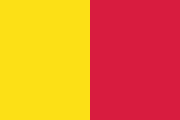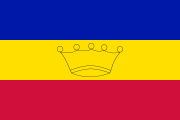Flag of Andorra
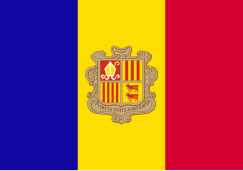 | |
| Use | State flag |
|---|---|
| Proportion | 7:10 |
| Adopted | 1866 (Tricolor) 1993 (official coat of arms) |
| Design | A vertical tricolour of blue, yellow and red with the National Coat of Arms centred on the yellow band. |
| Designed by | Napoleon III (traditionally attributed) |
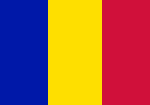 | |
| Use | Civil flag and ensign |
| Proportion | 7:10 |
| Adopted | 1866 |
| Design | A vertical tricolour of blue, yellow and red. |
| Designed by | Napoleon III |
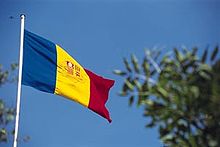
The national flag of Andorra (Bandera d'Andorra) features a vertical tricolour of blue, yellow, and red with the coat of arms of Andorra in the center. Although the three vertical bars may at first appear to be of equal width, the centre yellow bar is slightly wider than the other two so that the ratio of bar widths is 8:9:8 with an overall flag ratio of 7:10.
A civilian variant of the flag is said to have been created in 1866, although the design was standardized in 1993 after Andorra joined the United Nations.
Origins and symbolism
[edit]The design is related to the flags of Catalonia, Foix and France,[1] the lands historically linked with the small country. The coat of arms of Andorra in the center of the flag contains historical symbolism to the Catholic bishop of Urgell, the Count of Foix, the Principality of Catalonia, and the Viscounty of Béarn. The inclusion of the coat of arms makes it one of 28 national flags to contain overtly Christian symbolism[2] and it is the only national flag to portray cattle, except for the flag of Moldova, which is visually similar and features the head of a bull. A flag of three bars is similar to that of the French tricolor, while the pattern of a wider middle stripe can be noted on the Spanish flag. The motto in the coat of arms (written in Goudy Old Style) in the middle stripe Virtus Unita Fortior means "Virtue United is Stronger". The blue and red of the Andorran flag are also found on the French flag, with red and yellow also being the colors of the Catalonian flag (as the old royal symbol of the Crown of Aragon) and the arms of the old County of Foix (currently part of France).[3][4]
Description
[edit]Colors
[edit]The official colors of the Andorran flag are set out in the "Graphic regulations for reproducing the shield and flag" from the Oficina de Marques del Principat d'Andorra and approved by the government of Andorra on May 5, 1999.[5] The colors of the flag are:
| Color model | Blue | Yellow | Red | Khaki |
|---|---|---|---|---|
| Pantone | Blue 072 C | Yellow C | 199 C | PMS 466 C |
| CMYK | 100-99-2-3 | 2-9-100-0 | 10-100-86-2 | 23-30-61-1 |
| HEX | #10069f | #fedd00 | #d50032 | #c6aa76 |
Construction sheet
[edit]History
[edit]Pre-1806
[edit]During the Middle Ages, The Arabs of Muslim Spain, which occupied the territory in 714, did held white and black banners. after the establishment of The County of Urgell, claiming to be the last independent survivor of The Marca Hispanica, established by Charlemagne, Urgell held a checkered banner of black and gold by 988. Urgell made a condominium in the territory with The County of Foix in 1278 (being occupied by The Crown of Aragon in 1396 and 1512 and later The Principality of Catalonia in 1413), later to The Kingdom of Navarre in 1479 and finally with The Kingdom of France in 1620. the flags of those countries flew in Andorra during the times of the condominium. after the condominium was abolished during The French Revolution, Urgell became part of France (using the French Tricolor in Andorra), until 1806, when Andorra gained autonomy and its Co-Principate reestablished in 1809 (only gaining independence in 1814, after The Napoleonic Wars).
First flag
[edit]The historical flag of Andorra, which was used from 1806 to 1866, featured two equally sized red and yellow vertical (sometimes horizontal) bands. It is claimed that this flag was granted by Napoleon in 1806 but use of the flag may go back to much earlier. Red and yellow are the traditional colors of the lands adjacent to the Pyrenees, such as Foix, Roussillon, Toulouse and Crown of Aragon.
Second flag
[edit]A variant of the modern flag without the coat of arms is said to have been designed by Napoleon III, adding a blue stripe representing France (because colours of the old flag started to resemble too much only the new flag of Spain). The adoption of the new flag coincided with the New Reform led by Guillem d'Areny-Plandolit, who may be the real creator of the flag. The package of reforms, which included a new flag, was first adopted by the Episcopal Co-Prince, Bishop Josep Caixal i Estradé on April 22, 1866 and three years later by Napoleon III.[6][7] The flag from this period remains the official civil flag today, but due to its similarity to other national flags it is rarely used.
Third flag
[edit]The circumstances surrounding the introduction of the horizontal version of the flag are unknown. It is also unknown whether this was the only version at that time. In his 1898 book "Through the High Pyrenees" by Harold Spender he wrote:
- We were not fortunate enough to see the Andorran Council General in session, any more than we witnessed the fetes and dances which were seen by M. Vuillier on the occasion of the Feast of St. Etienne. During the session the Andorran flag—with three horizontal lines of blue, yellow, and red, and a crown in the centre— hangs out of the window. A description of the meeting of the Council has been given by M. Vidal...[8]
Horizontal flags were used until the end of the 1930s, in the meantime, the Spanish flag was changed to a similar one. The flag with crown is sometimes associated with the activities of Boris I, but there is no evidence for this.[9]
Later flags
[edit]Around 1939, the vertical arrangement was returned and a coat of arms was added. The yellow lane was probably widened later. Until the introduction of an official, standardized design in the Constitution of April 28, 1993, the flag variants differed from each other. An additional impulse to unify the flag were the plans to join the United Nations, which took place on 28 July 1993.[9][10]
Other flags of Andorra
[edit]Parish flags
[edit]| Flag | Parish | Adopted | Description | |
|---|---|---|---|---|
 |
 |
Andorra la Vella | ||
 |
 |
Canillo | ||
 |
 |
Encamp | ||
 |
 |
Escaldes-Engordany | ||
 |
 |
La Massana | ||
 |
 |
Ordino | ||
 |
 |
Sant Julià de Lòria | ||
Other
[edit]| Flag | Duration | Use | Description |
|---|---|---|---|
 |
c 2018-present |
Flag of the Andorran Olympic Committee |
|
 |
?-present |
Flag of the Police Corps of Andorra |
|
 |
c 1960s-? |
Flag of the Police Corps of Andorra |
See also
[edit]References
[edit]- ^ "Historical Flags (Andorra)". Flags of the World. 6 May 2015. Retrieved 12 August 2017.
- ^ Green, Michael (20 March 2015). "Flags, for God's Sake". brandingthenations.com. Archived from the original on 3 February 2020. Retrieved 3 February 2020.
- ^ Whitney, Smith. "Flag of Andorra". Encyclopedia Britannica. Retrieved 11 March 2020.
- ^ "Flag Andorra, flags Andorra". www.flags-and-anthems.com. Archived from the original on 31 July 2020. Retrieved 11 March 2020.
- ^ "Llibre de normes gràfiques per a la reproducció i aplicació dels signes d'Estat per als quals el Govern és autoritat competent". Govern d'Andorra. Retrieved 21 January 2024.
- ^ Andorra, país de pas i de refugi. Andorra: Societat Andorrana de Ciències. 2016. p. 85-88. ISBN 978-99920-61-30-5.
- ^ Nacional 2018.
- ^ Harold Spender (1898). Through the High Pyrenees. A. D. Innes, Limited. p. 67. ISBN 9781331882091.
- ^ a b "Historical Flags (Andorra)". fotw.info. Retrieved 11 March 2020.
- ^ Marsenyach, Albert Daina. "Història de la bandera i l'escut d'andorra". El Coprincipat d'Andorra ara fa molt de temps. (in Catalan). Retrieved 11 March 2020.
"Andorra promulga la Nova Reforma". El Nacional (in Catalan). 22 April 2018. Retrieved 2 May 2018.
External links
[edit]- Andorra at Flags of the World
- Normes Grafiques (PDF)


